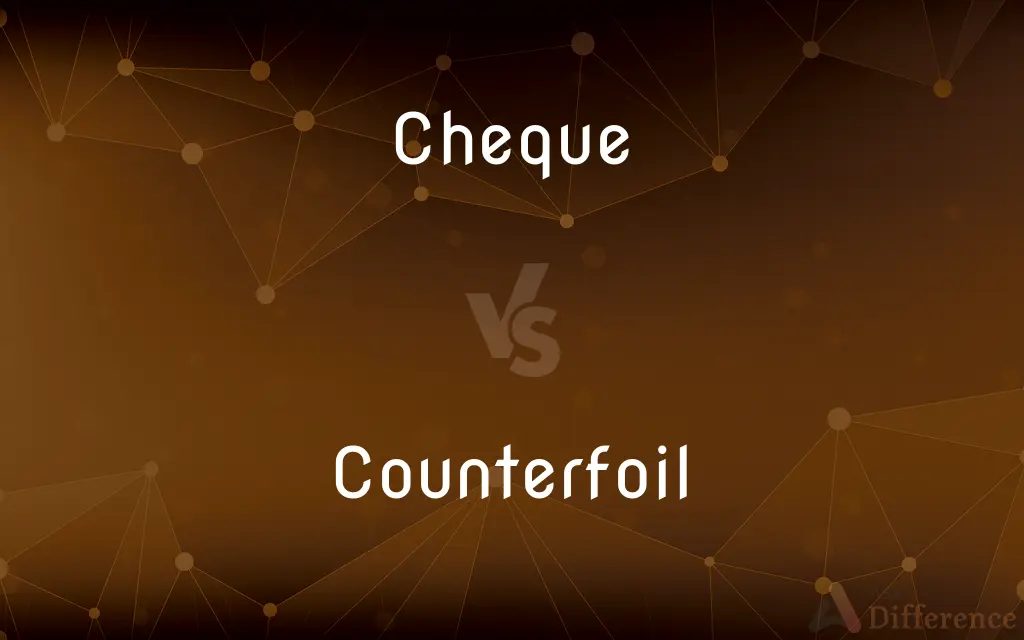Cheque vs. Counterfoil — What's the Difference?
By Tayyaba Rehman & Fiza Rafique — Updated on April 27, 2024
A cheque is a written, dated, and signed instrument that directs a bank to pay a specific sum of money to the bearer, whereas a counterfoil is the part of the cheque left in the chequebook as a record of the transaction.

Difference Between Cheque and Counterfoil
Table of Contents
ADVERTISEMENT
Key Differences
A cheque serves as a method of non-cash payment, allowing individuals or entities to transfer funds from one bank account to another. On the other hand, a counterfoil, also known as a cheque stub, acts as a record-keeping tool, retained in the chequebook after the cheque itself is removed and issued.
The primary function of a cheque is to provide a secure and documented way to authorize payment from one person's bank account to another's account or to a bearer. In contrast, the counterfoil summarizes the transaction, capturing details like the date, payee, amount, and sometimes a purpose, which helps the cheque issuer keep track of expenditures.
Cheques are a formal financial instrument processed by banking institutions, requiring verification of signatures and account details. Whereas counterfoils are used by the cheque issuer for personal record keeping and do not undergo any banking processing.
Modern banking practices include the digitization of cheques but retain the practical use of counterfoils, especially for individuals and businesses who prefer physical records for bookkeeping or tax purposes.
While the cheque is handed over to the recipient or deposited in a bank, the counterfoil remains with the issuer, serving as evidence of the transaction and helping in managing financial accounts and reconciliations.
ADVERTISEMENT
Comparison Chart
Definition
A document ordering a payment of money from a bank
A section of a cheque left in the chequebook as a record
Function
To transfer money
To record transaction details
Use in Transactions
Given to payee or bank
Retained by the issuer for personal records
Legal Status
Can be used as a legal document for payment
No legal standing, used for personal reference
Processing
Processed by banks
Not processed by banks, used for personal reference
Compare with Definitions
Cheque
May be subject to bank fees and processing times.
The bank charges a fee for processing cheques.
Counterfoil
The part of the cheque that is kept in the chequebook as a record.
He filled out the counterfoil with the payment details.
Cheque
Can be canceled or stopped if necessary.
He stopped the cheque upon realizing he'd made an error.
Counterfoil
Often used by businesses to reconcile accounts.
The accountant used the counterfoils to reconcile the monthly expenses.
Cheque
A written order to a bank to pay the stated amount from one's account.
He wrote a cheque for $500.
Counterfoil
Contains similar details as the cheque for consistency.
Ensure the amount on the counterfoil matches that on the cheque.
Cheque
Used widely for transactions where direct cash payment is not feasible.
She prefers to pay her rent by cheque.
Counterfoil
Helps in tracking expenses and maintaining financial records.
She checked the counterfoil to confirm the amount she had paid.
Cheque
A cheque, or check (American English; see spelling differences), is a document that orders a bank to pay a specific amount of money from a person's account to the person in whose name the cheque has been issued. The person writing the cheque, known as the drawer, has a transaction banking account (often called a current, cheque, chequing or checking account) where their money is held.
Counterfoil
Provides a backup record in case of disputes or errors.
The counterfoil was used to verify the payment when the cheque was lost.
Cheque
An order to a bank to pay a stated sum from the drawer's account, written on a specially printed form
They presented him with a cheque for £4,000
Fees are payable by cheque or postal order
Counterfoil
A stub retained by the issuer of a receipt or other document as a record of a transaction.
Cheque
Variant of check.
Counterfoil
The part of a cheque that is retained in the chequebook as a record; a stub
Cheque
A draft directing a bank to pay money to a named person or entity.
I was not carrying cash, so I wrote a cheque for the amount.
Sometimes abbreviations are used (which would be explained on the statement) and only the last three figures of the cheque number may be given. ‘Sundries’ are cash or cheques paid into the account.
You can avoid dealing with paper cheques — written or printed — by paying your bills online.
The daily cheque clearings began around 1770 when bank clerks met at the Five Bells (a tavern in Lombard Street in the City of London) to exchange all their cheques in one place and settle the balances in cash.
Counterfoil
That part of a tally, formerly in the exchequer, which was kept by an officer in that court, the other, called the stock, being delivered to the person who had lent the king money on the account; - called also counterstock.
Cheque
Obsolete form of chequy
Counterfoil
The part of a writing (as the stub of a bank check) in which are noted the main particulars contained in the corresponding part, which has been issued.
Cheque
See Check.
Counterfoil
The part of a check that is retained as a record
Cheque
A written order directing a bank to pay money;
He paid all his bills by check
Cheque
Withdraw money by writing a check
Cheque
Requires proper endorsement for processing.
Please ensure you sign the back of the cheque before depositing.
Common Curiosities
How important are counterfoils in digital banking?
In digital banking, physical counterfoils are less common, but digital records of transactions serve a similar purpose in tracking and reconciling accounts.
Can a counterfoil be used as proof of payment?
While it serves as a record for the issuer, the counterfoil itself is not legal proof of payment. The processed cheque serves as proof.
What information should be recorded on a counterfoil?
The counterfoil should include the date, payee name, amount, and optionally, the purpose of the payment.
Are counterfoils always attached to chequebooks?
Yes, counterfoils are typically part of a standard chequebook, providing a convenient method for tracking cheque usage.
Do counterfoils have any security features?
Counterfoils may include security features such as serial numbers or watermarks to help prevent fraud or unauthorized use.
Can counterfoils be used as proof of payment?
Yes, counterfoils can serve as proof that a cheque was issued, providing a record of the transaction for both the drawer and the payee.
What happens if there's a discrepancy between a cheque and its counterfoil?
Discrepancies should be resolved by referencing the bank statements and possibly contacting the bank if the error persists.
Is it safe to throw away old counterfoils?
It is advisable to retain counterfoils for a period consistent with financial record-keeping practices, typically several years, for tax and tracking purposes.
Why might a business prefer using cheques with counterfoils?
Businesses prefer using cheques with counterfoils for better financial management and reconciliation of accounts.
Can you use a cheque without a counterfoil?
While it's possible to use a cheque without the counterfoil portion, keeping the counterfoil helps in tracking expenditures and maintaining financial records.
Share Your Discovery

Previous Comparison
Flawless vs. Perfect
Next Comparison
Vindaloo vs. MadrasAuthor Spotlight
Written by
Tayyaba RehmanTayyaba Rehman is a distinguished writer, currently serving as a primary contributor to askdifference.com. As a researcher in semantics and etymology, Tayyaba's passion for the complexity of languages and their distinctions has found a perfect home on the platform. Tayyaba delves into the intricacies of language, distinguishing between commonly confused words and phrases, thereby providing clarity for readers worldwide.
Co-written by
Fiza RafiqueFiza Rafique is a skilled content writer at AskDifference.com, where she meticulously refines and enhances written pieces. Drawing from her vast editorial expertise, Fiza ensures clarity, accuracy, and precision in every article. Passionate about language, she continually seeks to elevate the quality of content for readers worldwide.













































